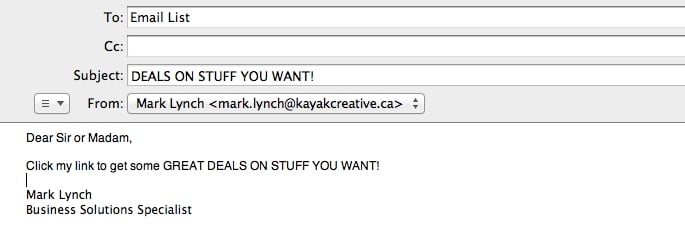Use The 3 Buckets Strategy To Convert Leads
Being successful with inbound lead generation is a wonderful thing. Every time you open up your inbox, there are new sales opportunities waiting for you.
But, simply generating leads doesn’t solve every problem a company can have. In fact, it can even create a couple of new ones. This became apparent recently when I was talking with a client who was receiving literally hundreds of well-qualified leads, but wasn’t having much luck turning them into actual customers.
What we discovered was that not everyone is well-versed in the process of turning qualified inbound leads into new accounts.
With this realization, I decided to sit down and spend some time with Marty Tascona of Deliberate Selling. He helped me understand a system virtually any small or medium-sized business can use, which we’ll call a “three bucket” sales funnel.
It works like this: every time a lead comes in, it’s assigned to one of three different categories…
The First Bucket is for Contacts Who Have Extremely Tight Budgets
They’re working within a constricted scope, and may evaluate the cost of doing business with you against their own personal earnings or salary. Not surprisingly, this bucket is most likely to be filled with employees or novice entrepreneurs. They tend to buy on price, and may not be knowledgeable about your industry, or even interested in learning about the value or ROI you can deliver. These prospects usually want the lowest cost option they can find.
They might sound like bad leads, but price conscious buyers can have tremendous value. The secret is to initially respond to them as information gatherers, rather than decision-makers. Acknowledge their interest, thank them for including you in their search, and then loop in their superiors or spouses as quickly as you can.
Get the business owner, division head, or senior executive involved – that person is more likely to understand what’s at stake, and take a longer view that isn’t motivated solely by price. If you can move the sale up the food chain before discussing dollars, you might be able to turn it into a real opportunity.
The Second Bucket is for Prospects Who Manage Budgets
The difference between prospects in this bucket is that they are searching for quality partners or suppliers, and probably aren’t evaluating your firm’s products or services against their own salaries. Instead, they may be intent on keeping within budget set by upper managers, but still want to see a successful outcome.

That’s because making the right decision might equate to bonuses, raises, or advancement for them. It shouldn’t be surprising, then, that these individuals are going to be project-oriented. They’ll try to restrict the scope of the investment to the issue at hand, and future work is a real possibility.
Your wisest strategy for dealing with prospects who fall into this bucket is to help them find a “quick win.” Define what success looks like for them, and then make sure they can achieve it. Scope out your initial project carefully, so you can be sure which metrics or deliverables matter the most to them.
Spend the time to let them know how closely you and your team will be working to help them reach their target, and then follow through. You might not get as much business as you’d like the first time around, but you’re going to be opening the door for more collaboration going forward.
The Third Bucket Is for Prospects Who Are Motivated by Business Growth
Generally, these kinds of inquiries come from executives in the V- and C- suites. They are the entrepreneurs, the dreamers, the doers, and the decision-makers. While budgets are always going to be a factor in any sales situation, the exact dollar amounts are going to be less of a barrier to these individuals.
That’s because they want to be the best, and are willing to spend the money on the tools or assistance that will help them move to the head of the pack. Because they want to create big successes, they are often willing to take larger risks.
Of course, any gamble they make is going to be mitigated by the skills, reputation, and promises of their chosen partner.

With these kinds of leads, your best approach is to talk about the big picture. Don’t focus narrowly on the details, because you’ll be working with employees on their side to finalize details of operation and execution.
High-level prospects want to hear about big plans, and see results from their investment as quickly as possible. They can turn on a dime, so make sure it’s your dime. They’ll give you the opportunity to shine if you’re willing to take it.
Using Your Three Buckets to Convert Leads Into Sales
Just as smart marketers develop content that’s appropriate for different personas, a savvy sales approach is to recognize the needs of each individual prospect that approaches you and communicate with them in terms that make sense for their needs.
By separating inquiries into three distinct buckets, you can develop a template and playbook that will help you connect with prospects in a way that ignites their interest.
The end result, of course, is that you’ll get better at figuring out what your potential clients need when they contact you, and will be able to do a better job of translating that back to them in your initial conversations.
Then, you can make full use of your inbound marketing campaigns and ensure your best opportunities aren’t slipping away because you took the conversation in a wrong direction.







